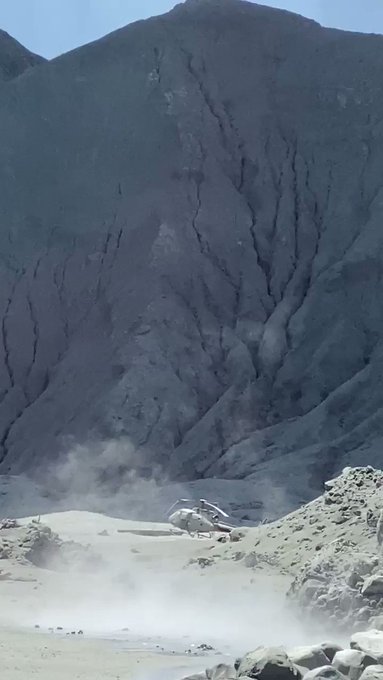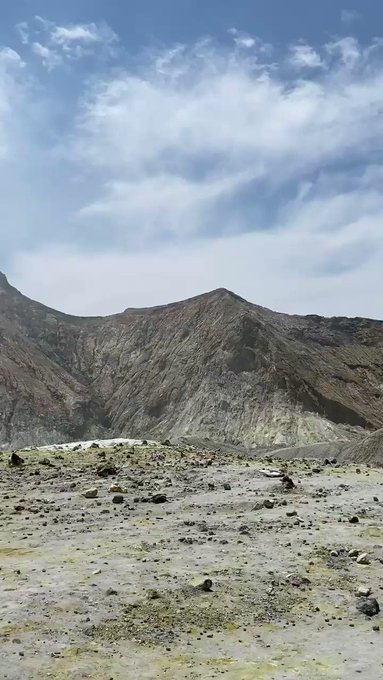https://www.thesun.co.uk/news/10511437/new-zealand-eruption-five-dead-two-brits-white-island/
VOLCANO HELL New Zealand volcano eruption – Five dead ‘& three Brits among up to 27 missing’ as White Island cops say ‘no survivors’
- 9 Dec 2019, 12:30
- Updated: 9 Dec 2019, 15:54
AT least five people have died and three Brits are feared missing after an eruption at the White Island volcano in New Zealand this morning.
Eighteen of an estimated 50 people were rescued from the island, with up to 27 still missing and cops saying they no longer expect to find more survivors.

14
A photo taken from a boat that had left the island just minutes before the eruptionCredit: Michael Schade/ Magnus News

14
A chilling final photo from inside the crater appears to show a group trekking through the volcano moments before it erupted

14
A helicopter is seen on the island covered in ashCredit: Michael Schade/ Magnus News
The volcano suddenly erupted at 2.11pm local time, sending a 12,000ft plume of smoke and rock into the air.
Images showed one group of people trekking across the centre of the volcano's crater just a minute before the eruption.
Twenty three people were brought off the island, of whom five later died.
The first victim has been identified as a tour guide for White Island tours.
Tony Bonne, former mayor of the coastal town of Whakatane, described the man as a young, energetic, and experience guide, news.com.au reported.
The disaster followed a series of warning signs that had been growing more alarming over recent weeks, as questions are asked about why tour groups were allowed to visit the island.
Survivors of the blast were taken to hospitals on New Zealand's North Island, many with severe burns.
Three Brits - two 67-year-old men and an 80-year-old woman - are listed as among those still missing on a website set up by the New Zealand Red Cross, the Evening Standard reported.
The Sun is not naming the trio because neither has been confirmed by authorities to have been on White Island.
A 27-year-old woman from London was also earlier listed as missing, but her family later confirmed her to be safe, according to the Standard.
The site was launched at the request of New Zealand police, although all information on the site is being submitted by concerned members of the public.
Police said people from overseas can also call +64 9105 105 to submit information about friends or family who might have been on White Island at the time of the blast.
Among those listed on the site as currently missing are people from Australia, Singapore, China, the Czech Republic, Guatemala, and Burma.
Around half of those on the island are thought to have been from Australia.
'NO SIGNS OF LIFE'
A statement released by New Zealand police just after midnight local time said reconnaissance flights over the island saw “no signs of life...at any point”.
It continued: “Police believe that anyone who could have been taken from the island alive was rescued at the time of the evacuation.
“Based on the information we have, we do not believe there are any survivors on the island.”
It added that officials were working "urgently" to determine how many people had died, and that the military would be deploying drones to survey the area at first light.
Just last month, authorities raised its Volcanic Alert Level to Level 2, as scientists observed increasing amounts of sulphur dioxide gas – a key indicator of rising magma deep in its bowels.
This afternoon, that alert level shot up to 4 – but has since come down to 3.
And there have been several eruptions in recent years, including two in 2016, with one expert saying the volcano was “'a disaster waiting to happen”.
Emeritus Professor Ray Cas, from Monash University, told the Australian Science Media Centre: “I have always felt that it was too dangerous to allow the daily tour groups that visit the uninhabited island volcano by boat and helicopter.”
Speaking at a press conference, New Zealand PM Jacinda Ardern said: "I know that there will be a huge amount of anxiety for those who had loved ones on the island at the time.
"I can assure them police are doing everything they can."
She is now reported to have arrived in the area and to be meeting with local officials.
Did you witness the volcano eruption? Are you or someone you know a tourist visiting the area? We want to hear from you. Contact our news desk on +44(0)207 782 4368 or email tips@the-sun.co.uk
CHILLING LAST PHOTO
A scientific monitoring camera appeared to capture a group of tourists walking through the volcano's crater at 2.10pm - just one minute before the eruption.
The camera - which takes a new still image every ten minutes - did not take another clear shot, and is believed to have been buried in rubble from the blast.
A fleet of rescue helicopters was dispatched to send emergency workers to the area in the hope of finding survivors.
Rescuers were able to reach the shore by boat, but National Operation Commander Deputy Commissioner John Tims told a press conference the island remained too dangerous to go further.
He added that there remained a possibility of further eruptions.


14
A group watch the eruption from a boatCredit: AFP

14
Paramedics tend to an injured person evacuated from the islandCredit: AP:Associated Press

14
An aerial view of the volcano in the aftermath of the eruptionCredit: AP:Associated Press
A statement from New Zealand's national police force said: "We are continuing to work as quickly as possible, through a number of channels of information, to confirm exact numbers of those involved, including those who remain on the island.
"Both New Zealanders and overseas tourists are believed to involved.
"Police is currently taking advice from GeoNet experts, who have advised that due to the current risk environment, emergency services remain unable to access the island.
"We are reassessing as information and advice is received, however Police will not be in a position to access the island tonight."
It added that a no-fly zone is now in place at five nautical miles around the island.
Dr. Jessica Johnson, a volcanologist at the University of East Anglia, told CNN: "There is a chance of another eruption of similar size ... and potentially bigger."
She also told the Guardian that the eruption was “unfortunate but not completely unexpected” because “levels of activity [in the volcano]... have been relatively high since September."
WHY DID WHITE ISLAND ERUPT?
Just below Earth's outer crust is a layer of magma, or liquid rock, known as the mantle.
Volcanoes form when pressure in the mantle begins to build, and magma is forced up through gaps in the Earth's crust.
In certain conditions, such as movements of the planet's tectonic plates or currents of heat in the mantle, the pressure will build further and, eventually, the volcano will erupt, throwing magma into the air.
New Zealand lies on the so-called Ring of Fire, a 25,000-mile chain of 452 volcanoes around the edge of the Pacific Ocean.
The ring runs up past Asia and Russia, across to Alaska, and down the westerly coasts of North and South America.
Since 1850, about 90 per cent of the most powerful eruptions in the world have happened along this boundary.
White Island was a very active volcano and questions are now being raised about whether tourists should ever have been allowed to visit.
Dr. Jessica Johnson, a volcanologist at the University of East Anglia, told the Guardian that increased numbers of small earthquakes and more volcanic gas detected than usual in recent weeks had seen the alert level raised.
Even with the alert levels raised, volcanic eruptions are notoriously difficult to predict.
Speaking to the Australia Science Media Centre, Raymond Cas of Monash University's School of Earth, Atmosphere, and Environment described White Island as a "disaster waiting to happen".
"Having visited it twice, I have always felt that it was too dangerous to allow the daily tour groups," he said.
[size=31]'WE GOT OFF JUST IN TIME'[/size]
New Zealand Cruise Association CEO Kevin O'Sullivan has said that between 30 and 38 passengers from Royal Caribbean cruise ship Ovation of the Seas were on the island at the time of the eruption.
In a post on Facebook, White Island Tours operator Calvin Kingi wrote that his company's group got off the island just in time.
"White Island just erupted as we left, we have our work mates and a tour still on the island, I hope they okay," he said.
Tourist Michael Schade gave a harrowing account of the blast - saying his tour boat left the island just 30 minutes earlier.
He wrote on Twitter: "Woman my mom tended to was in critical condition but seemed strong by the end.
"The helicopters on the island looked destroyed.
"This is so hard to believe. Our whole tour group were literally standing at the edge of the main crater not 30 minutes before."
- Quote :

Michael Schade@sch
· 11h
Replying to @sch
[ltr]Those are some of the people put boat picked up. Praying for them and their recovery. Woman my mom tended to was in critical condition but seemed strong by the end.
The helicopters on the island looked destroyed:[/ltr]

- Quote :

Michael Schade@sch
[ltr]This is so hard to believe. Our whole tour group were literally standing at the edge of the main crater not 30 minutes before. My thoughts with the families of those currently unaccounted for, the people recovering now, and especially the rescue workers…[/ltr]

20:35 - 8 Dec 2019 · White Island
[ltr][/ltr]
'IT CAME OUT OF NOWHERE'
Authorities asked people on North Island, one of New Zealand's two main islands, to avoid areas nearest the volcano - about 30 miles from the mainland.
The "short-lived eruption" threw an ash plume about 12,000ft high, New Zealand's geoscience agency GNS Science said in a statement.
Skydiver Guillaume Calmelet was preparing for a tandem dive ahead of the eruption, and saw a plume developing above the volcano as he leapt from the plane.
"This big white cloud came out of nowhere," he told the New Zealand Herald.
"We've never seen anything like that."
White Island, northeast of the North Island town of Tauranga, is regularly visited by small groups of tourists.
The cone volcano is New Zealand's most active and about 70 per cent of it is below sea level.
DEADLY VOLCANO
Twelve people were killed on the island in 1914 when it was being mined for sulphur.
Part of a crater wall collapsed and a landslide destroyed the miners' village and the mine itself.
The remains of buildings from another mining enterprise in the 1920s are now a tourist attraction.





